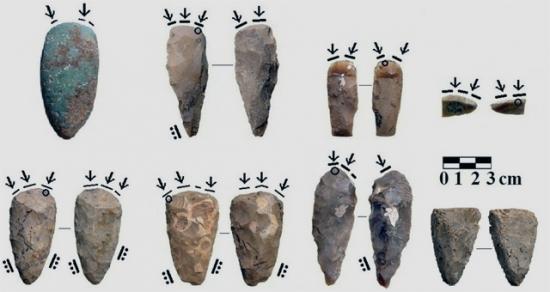Source - http://www.sci-news.com/archaeology/article00525.html
A new study by Tel Aviv University scientists shows that the transition from hunting to agricultural society during the Neolithic age parallels development of woodworking tools. The study suggests that humans started using heavy-duty axes to cut and carve wood as early as 8,000 BCE.

A polished greenstone axe, top left, and flint tranchet axes found by Tel Aviv University scientists at the archaeological site of Motza: black lines show the extent of the wood-working microwear traces, arrows show the orientation of the polish and striations, lines with dots show location of hafting traces (Yerkes et al / PLoS ONE)
During the Neolith (about 10,000–6,000 BCE), early man evolved from hunter-gatherer to farmer and agriculturalist, living in larger, permanent settlements with a variety of domesticated animals and plant life. This transition brought about significant changes in terms of the economy, architecture, man’s relationship to the environment, and more.
The research, published in the journal PLoS ONE, sheds light on this milestone in human evolution, demonstrating a direct connection between the development of an agricultural society and the development of woodworking tools.
“Intensive woodworking and tree-felling was a phenomenon that only appeared with the onset of the major changes in human life, including the transition to agriculture and permanent villages,” said senior author Dr Ran Barkai of the Tel Aviv University’s Department of Archaeology and Ancient Near Eastern Civilizations.
“Prior to the Neolithic period, there is no evidence of tools that were powerful enough to cut and carve wood, let alone fell trees. But new archaeological evidence suggests that as the Neolithic age progressed, sophisticated carpentry developed alongside agriculture.
The use of functional tools in relation to woodworking over the course of the Neolithic period has not been studied in detail until now. Dr Barkai and his fellow researchers have unearthed evidence at the archaeological site of Motza, a neighborhood in the Judean Hills, that increasing sophistication in terms of carpentry tools corresponds with increased agriculture and permanent settlements.
“The early part of the Neolithic age is divided into two distinct eras — Pre-Pottery Neolithic A (PPNA) and Pre-Pottery Neolithic B (PPNB). Agriculture and domesticated plants and animals appear only in PPNB, so the transition between these two periods is a watershed moment in human history. And these changes can be tracked in the woodworking tools which belong to each period,” Dr Barkai explained.
Within PPNA, humans remained gatherers but lived in more permanent settlements for the first time, he says. Axes associated with this period are small and delicate, used for light carpentry but not suited for felling trees or other massive woodworking tasks.
In PPNB, the tools have evolved to much larger and heavier axes, formed by a technique called polishing.
The researchers’ in-depth analysis of these tools shows that they were used to cut down trees and complete various building projects.
“We can document step by step the transition from the absence of woodworking tools, to delicate woodworking tools, to heavier woodworking tools,” Dr Barkai said, and this follows the “actual transition from the hunter-gatherer lifestyle to agriculture.”
Bibliographic information: Yerkes RW, Khalaily H, Barkai R. 2012. Form and Function of Early Neolithic Bifacial Stone Tools Reflects Changes in Land Use Practices during the Neolithization Process in the Levant. PLoS ONE 7(8): e42442; doi: 10.1371/journal.pone.0042442